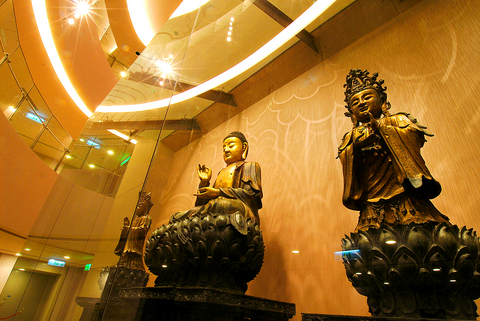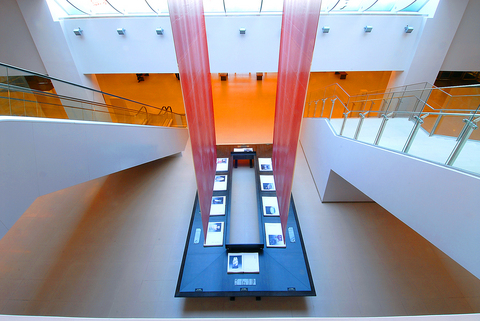Stepping into the 41-year-old National Palace Museum (NPM, 國立故宮博物院) in Taipei, one can't help but wonder what has happened to the once dust-covered depository of ancient treasures, now transformed into a bright, spacious modern museum replete with contemporary design inspired by the artwork from its collections.
The renovation project was begun in 2002 to remedy the museum's lack of exhibition space and its antiquated fire and quakeproofing and is now nearing completion with the last galleries under construction due to open to the public in February.
"The museum now has far more public spaces and the exhibition rooms have been rearranged in a more sensible manner so that visitors can easily find their way around," Sylvia Sun (孫鳳儀) of the museum's public affairs office said.

PHOTOS COURTESY OF NATIONAL PALACE MUSEUM
Departing from a theme-oriented format, the East Wing galleries chronologically chart Chinese civilization from the Neolithic age to the late Ching Dynasty. A multi-media exhibition booth on the second floor demonstrates ancient bronze-making techniques. More digital and sound exhibitions are to come, Sun said, including a guide room that presents visitors with information about the museum before visitors embark on their tours.
While the museum's southern branch in Taibao City, Chiayi County (嘉義縣太保市) — a grand project that has been attacked for exceeding its original NT$5.9 billion with accusations of bribery and corruption being leveled against officials and construction companies — is scheduled for completion in 2010 the NPM in Taipei seems ready to take a big leap into the new millennium with a total makeover and a change of mentality.
Under the leadership of its director Lin Man-li (林曼麗), the museum is no longer limited to its traditional role as a cultural showroom attracting mainly foreign tourists. Rather, it is envisaged as a cultural park where families and friends could hang out and while away leisure time in the e-learning demonstration center, child-friendly workshops, auditorium for film screenings and cafes (the nearby Formosa International Hotel-run three-floor building housing restaurants and eateries will be open to the public by the end of next year.)

The gift shop and e-commerce Web site carry an array of items whose designs are based on famous pieces from the museum's collection and demonstrate the museum's ambition to become a player in the cultural industries and create added value through brand building.
To herald its official reopening on Feb. 8 next year, the museum is launching a three-month long special exhibition on paintings, calligraphy, rare books and the Ju ceramic wares from the Northern Sung Dynasty (960 to 1127) starting on Monday. Renowned for its impressive collection of artworks of the period, the museum is putting its collection of Sung Dynasty artifacts in its entirety on display for the first and possibly the last time due to the fragility of the artworks.
"The museum usually displays one or two items of the period at a time since the ancient paintings and calligraphy pieces are what we call the restricted items. Every time we roll open a piece, it damages the work. And the duration of the exhibition of such restricted item is limited to two to three months. After the display, the items have to be returned to the storehouse for repair, which can take years," Sun explained.
A month-long celebration will kick off in February with a series of outdoor performances by local groups such as U-Theater (優劇場), Ju Percussion Group (朱宗慶打擊樂團) and Ming Hua Yuan Taiwanese Opera (明華園歌仔戲團). The British Museum will collaborate with the NPM for the first time, shipping 271 selected masterpieces for a large-scale exhibition. Visit the museum's Web site at www.npm.gov.tw.

In the March 9 edition of the Taipei Times a piece by Ninon Godefroy ran with the headine “The quiet, gentle rhythm of Taiwan.” It started with the line “Taiwan is a small, humble place. There is no Eiffel Tower, no pyramids — no singular attraction that draws the world’s attention.” I laughed out loud at that. This was out of no disrespect for the author or the piece, which made some interesting analogies and good points about how both Din Tai Fung’s and Taiwan Semiconductor Manufacturing Co’s (TSMC, 台積電) meticulous attention to detail and quality are not quite up to

April 21 to April 27 Hsieh Er’s (謝娥) political fortunes were rising fast after she got out of jail and joined the Chinese Nationalist Party (KMT) in December 1945. Not only did she hold key positions in various committees, she was elected the only woman on the Taipei City Council and headed to Nanjing in 1946 as the sole Taiwanese female representative to the National Constituent Assembly. With the support of first lady Soong May-ling (宋美齡), she started the Taipei Women’s Association and Taiwan Provincial Women’s Association, where she

Chinese Nationalist Party (KMT) Chairman Eric Chu (朱立倫) hatched a bold plan to charge forward and seize the initiative when he held a protest in front of the Taipei City Prosecutors’ Office. Though risky, because illegal, its success would help tackle at least six problems facing both himself and the KMT. What he did not see coming was Taipei Mayor Chiang Wan-an (將萬安) tripping him up out of the gate. In spite of Chu being the most consequential and successful KMT chairman since the early 2010s — arguably saving the party from financial ruin and restoring its electoral viability —

It is one of the more remarkable facts of Taiwan history that it was never occupied or claimed by any of the numerous kingdoms of southern China — Han or otherwise — that lay just across the water from it. None of their brilliant ministers ever discovered that Taiwan was a “core interest” of the state whose annexation was “inevitable.” As Paul Kua notes in an excellent monograph laying out how the Portuguese gave Taiwan the name “Formosa,” the first Europeans to express an interest in occupying Taiwan were the Spanish. Tonio Andrade in his seminal work, How Taiwan Became Chinese,